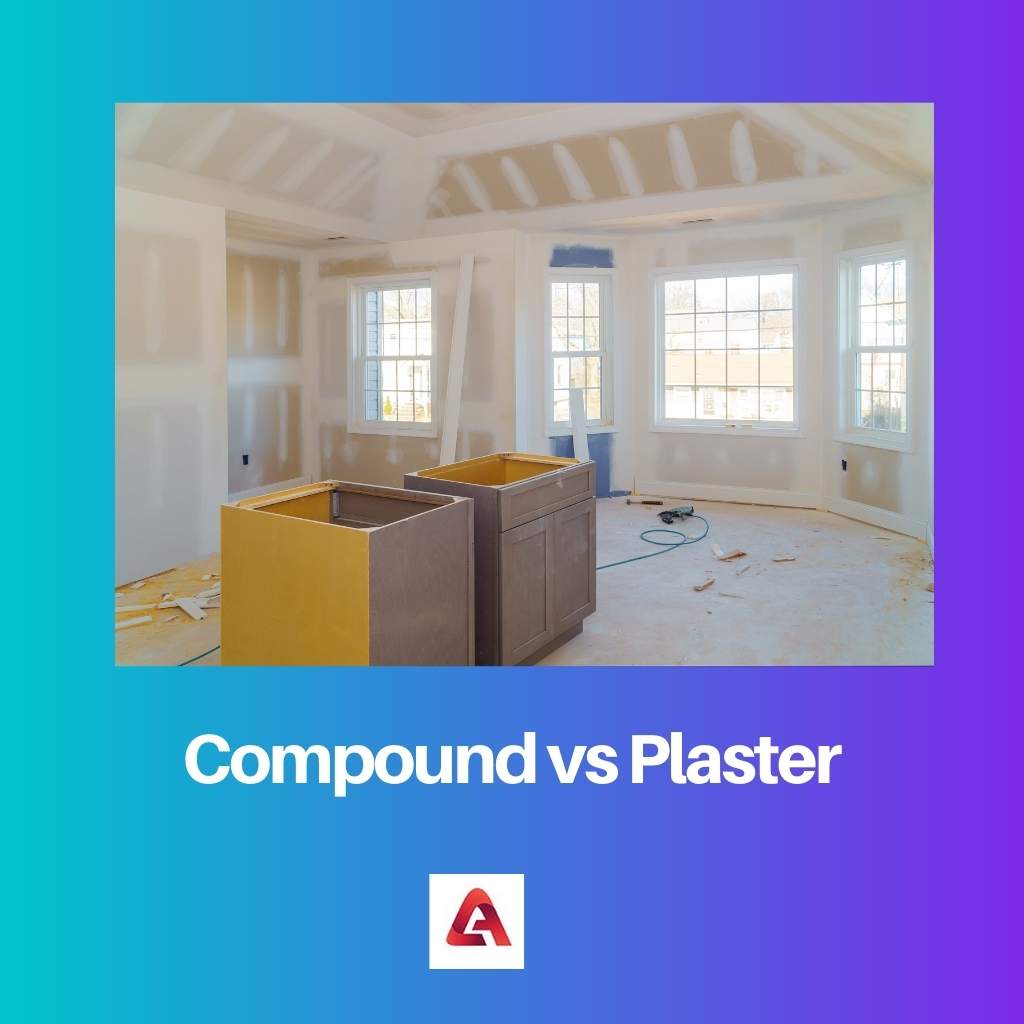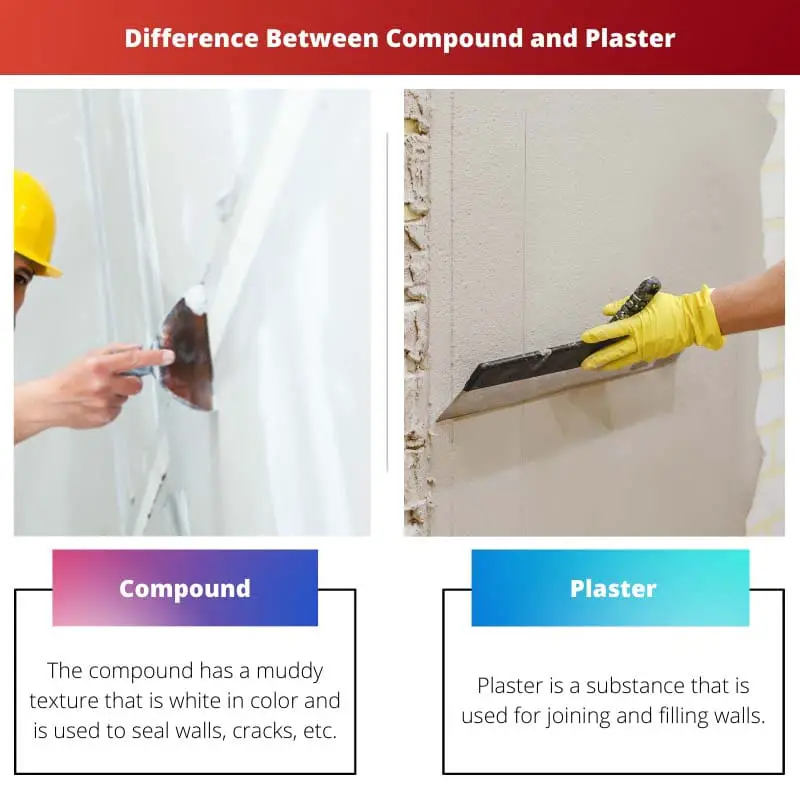Chemicals have always amazed us with surprising experiments. Compound and Plaster are two kinds of cementing materials that are used for fixing walls and cracks. The Compound takes time to settle, but Plaster is too quick. These two terms came into action during construction work.
The Compound, also called drywall compound, is whitish in color containing gypsum. And Plaster is a mixture of either gypsum, lime, or cement. The compound is mixed with a small amount of water to get a consistent thick or mud-like paste, which can be applied to walls or cracks.
Key Takeaways
- Plaster is a type of building material made from gypsum, water, and sand, while the compound is a general term for various materials used in construction.
- Plaster is used for covering walls and ceilings, while compound can be used for many different purposes, including filling gaps, sealing joints, and repairing surfaces.
- Plaster is a more traditional and time-tested material, while the compound is a more modern and versatile material that can be customized for specific applications.
Compound vs Plaster
A compound, specifically a joint compound, is a paste used to seal gaps between drywall panels and smooth surface imperfections. Plaster is a mixture of lime or gypsum, sand, and water, primarily used to create interior walls and ceilings.

The compound has a muddy texture that is white in color and is used to seal walls, cracks, etc. No skills are needed to apply Compound to your walls. One needs to add a subtle amount of water to it.
It is smooth in texture, which helps it expand easily; after the moisture is lost, the compounds get hardened.
Plaster is also a substance that is used for fixing, filling walls and cracks. It contains one among the compounds like gypsum, cement, or lime. It settles very quickly, and it is a powder that is white in color and is mixed with some amount of water before its application.
Comparison Table
| Parameters of Comparison | Compound | Plaster |
|---|---|---|
| Definition | The compound has a muddy texture that is white in color and is used to seal walls, cracks, etc. | Plaster is a substance that is used for joining and filling walls. |
| Compounds contained | The compound only contains gypsum as its main material. | Plaster can have either gypsum, lime, or cement as their main material. |
| Drying time | It takes time to lose moisture and drying out. | It does not take much time and dries out quickly. |
| Skills required | No skills are required for its application. | It requires some skills for its application or implementation. |
| Moulding feature | A compound cannot be mold into different shapes. | It can be molded into different shapes when its texture is soft. |
| Existence | It exists as a mineral and is pure in the form which occurs naturally. | It is made by humans after adding materials in requires proportions. |
| Chemical name | Calcium sulfate dihydrate. | Calcium sulfate hemihydrate. |
What is Compound?
The compound is calcium sulfate dihydrate which is used for fixing cracks or holes in a wall and is mainly used as a first layer before applying paint to the wall. It is for small fixes or work and can also be applied by unskilled people because it does not require specific proportions during mixing.
The compound is pure in form and occurs naturally, unlike Plaster, a man-made material. Because it hardens quickly, it cannot be molded into different shapes. When applied to walls, it makes the wall smooth in texture and equal to the smooth application of wall paints.
The Compound texture is like plastic and is a little bit flexible, so it is mostly for the finishing touches. Multilayer coating is needed when using Compound because it does not provide a smooth texture in the first layer.

What is Plaster?
Plaster is used for decoration and safety as it protects the wall and makes it water-resistant. It mainly contains a mixture of either gypsum, lime, or cement. It needs some skills for its application because its materials need to be added in measured proportions.
It is calcium sulfate hemihydrate, also used for making statues because it has a clay-like structure and can be molded into different shapes easily, but only before the moisture loss. Because once the moisture is lost, it becomes hard and tough to break.
Plaster is mixed with water, and then the exothermic reaction takes place, which takes away its moisture by making it hard. It is also used by doctors for bone-joining purposes. Plaster is kept away from moisture because it becomes purposeless once it comes in contact with moisture.

Main Differences Between Compound and Plaster
- The compound only contains gypsum, it does not settle quickly, and it takes time after applied to drying. While Plaster either contains gypsum, cement, or lime, and it settles very quickly also, after application, it dries out instantly.
- The Compound is used for filling cracks and small purposes, while the Plaster is used for joining bricks, walls, etc.
- Plaster settles very quickly and does not take much time to dry. That is why most of the construction work is done with the help of plaster, but the Compound takes time to settle and lose moisture, which is why it is mostly used for small jobs.
- The compound exists as a mineral and is pure in the form which occurs naturally. In contrast, Plaster is made by humans after adding materials in the required proportions.
- A compound cannot be molded into different shapes because it hardens and loses its moisture, making its structure tough. On the other hand, Plaster can be molded into a different shape because of its soft structure and clay-like texture.

- https://scripts.iucr.org/cgi-bin/paper?S0365110X58000128
- https://link.springer.com/article/10.1007/BF00354546

The article’s discussion on the human and natural origins of compound and plaster is intriguing. It’s interesting to consider the historical and practical contexts of these building materials.
The comparison of compound and plaster is not just informative, but also provides a unique perspective on the evolution of construction materials throughout history.
Yes, the historical and cultural aspects of these materials are overlooked. It’s great to see them explored in this article.
This article has certainly broadened my understanding of compound and plaster. The detailed examination of their chemical compositions and applications offers a nuanced view of these materials.
I share your sentiment. The depth of analysis in this article provides a comprehensive perspective on the functionalities of compound and plaster.
The clear distinction in the physical properties of compound and plaster is enlightening. Understanding the textures and moldability of each material deepens our appreciation for their utility.
I couldn’t agree more. The detailed comparison of the tactile characteristics of compound and plaster adds a fascinating dimension to the discussion.
The focus on the touch and feel of these materials is indeed unique. It offers an insightful perspective on the practical uses of compound and plaster.
This article provides a comprehensive and informative comparison between compound and plaster. It’s interesting to learn about the differences in composition and applications of these two building materials.
I completely agree. The detailed explanation of the chemical composition and properties of each material is very enlightening.
I can’t help but appreciate the scientific approach taken in this article. The chemical names and reactions provide a fascinating insight into the nature of these building materials.
Absolutely, the scientific details in the article add an intellectual depth to the analysis of compound and plaster.
The article effectively dissects the properties and uses of compound and plaster. The emphasis on both scientific and practical aspects provides a well-rounded understanding of these construction materials.
Indeed, the holistic analysis of compound and plaster presented in this article is commendable. It offers a comprehensive view of these building materials.
The information about the characteristics of compound and plaster is very well articulated. I appreciate the attention to detail in describing the textures and drying times of each material.
I couldn’t agree more. The article’s focus on the physical attributes of compound and plaster adds a layer of understanding to the comparison.
While the article is informative, I feel that the discussion on applications could be further expanded. A more in-depth exploration of real-world uses would enhance the content.
I agree. A deeper look into practical uses and examples of where compound and plaster are employed would make this article even more insightful.
I found this article to be quite useful. It helped me understand the actual differences between the compound and plaster, and the specific purposes each one serves.
Yes, the clear comparison table simplifies the key differences, making it easy to distinguish between compound and plaster.
While the article lays out the differences between compound and plaster clearly, I believe a more critical analysis of the environmental impacts of each material would add depth to the comparison.
Environmental considerations are indeed crucial. Exploring the eco-friendliness of compound and plaster would enrich the scope of this article.
Absolutely, an examination of the sustainability and ecological aspects of these building materials would be an enlightening addition to this comparison.